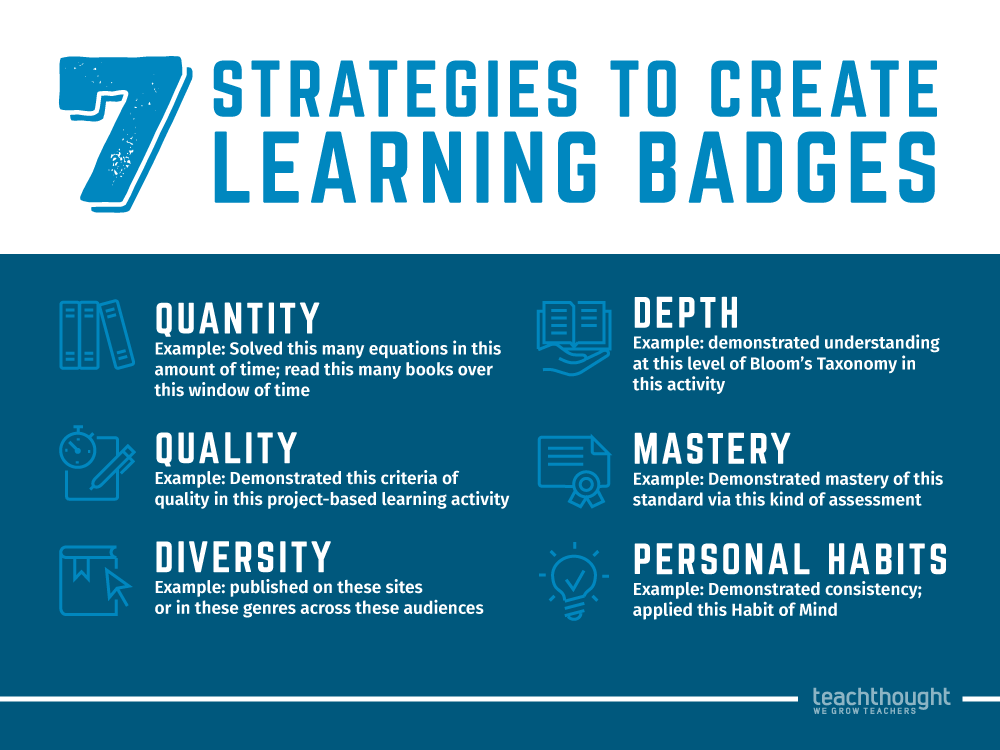Grade Differently: 7 Categories To Create Learning Badges
The effect of well-designed learning badges is a kind of encouragement mechanic that helps students see their own progress.

What Are The Best Strategies To Create Learning Badges?
How can you help students see their own progress? And use that to motivate them?
Encouragement mechanics–a kind of gamification–is one approach. And note, you needn’t make that lesson or unit feel like a ‘video game.’ That’s not gamification. Gamification is simply the application of game-like mechanics to ‘non-games.’
So here, we’d be taking a lesson from games and applying them to student progress. One of the most obvious ways to do this would be to create learning badges are pretty cool.
On the surface, they seem a bit like the gold stars of yesteryear, and they are–but they’re better. A badge is simply a visual icon that represents something–a talent, skill, achievement, etc. Kind of like Scout badges, but digital, and completely customizable per student, teacher, or classroom.
Like encouragement mechanics, learning badges often get confused with gamification as well when in fact they are just strategies that can be used to realize gamification. Gamification–making a ‘game’ out of something that’s not–is different. The effect is a kind of encouragement mechanic that helps students see their own progress. Put another way, seeing one’s progress is a strategy for encouragement.
Put another way, seeing one’s progress is a strategy for encouragement.
But they don’t have to be used to encouraged; they can be used to uncover, reveal, and emphasize. In How Gamification Uncovers Nuance In The Learning Process, I explained the benefit.
“A digital trophy system–if well-designed–offers the ability to make transparent not just success and failure, accolades and demerits, but every single step in the learning process that the gamification designer chooses to highlight. Every due date missed, peer-collaborated with, sentence revised, story revisited, every step of the scientific process and long-division, every original analogy, tightly-designed thesis statement, or exploration of push-pull factors–every single time these ideas and more can be highlighted for the purposes of assessment, accountability, and student self-awareness.”
This is all oversimplified, of course. How to actually manage this on a daily basis in your classroom is an altogether different beast. But I thought it might be helpful to consider themes and categories as innovative strategies to begin thinking out how they might work for you.
And to be clear–they don’t have to be digital badges. Think of a letter grade as the crudest and misleading and basic learning badge ever created, then work up from there. What else could you create to help students publish their skills, see their own progress, and grow in your classroom?
7 Categories For Creating Learning Badges For Students
1. Quantity
Example: You solved this many equations in this amount of time, read this many books over this window of time
2. Quality
Example: You demonstrated this criteria of quality in this project-based learning activity
3. Collaboration
Example: You improved this product in this specific way using collaboration
4. Diversity
Example: You published on these sites or in these genres across these audiences
5. Depth
Example: You demonstrated understanding at this level of Bloom’s Taxonomy in this activity
6. Mastery
Example: You demonstrated mastery of this standard via this kind of assessment
7. Personal Habits
Example: You demonstrated use of this Habit of Mind
Conclusion
As you can see, the possibilities are endless. And with free resources like badgestack, all that’s left is pick a way to get started.
I’d start small—maybe 3 badges in a single unit students can earn—a very ‘whole class,’ carrot stick approach.
But as you build an understanding of how it can work, instead of using them as encouragement mechanics, you can instead use them to amplify the performance of the students to all stakeholders, blowing away the letter grade as the crude, impotent, singular badge that it is.
Encouragement Mechanics In The Classroom
